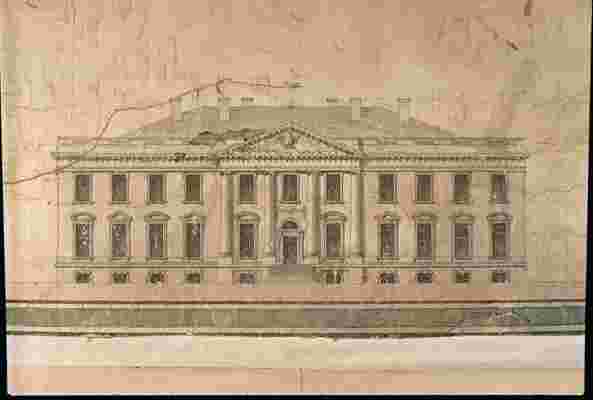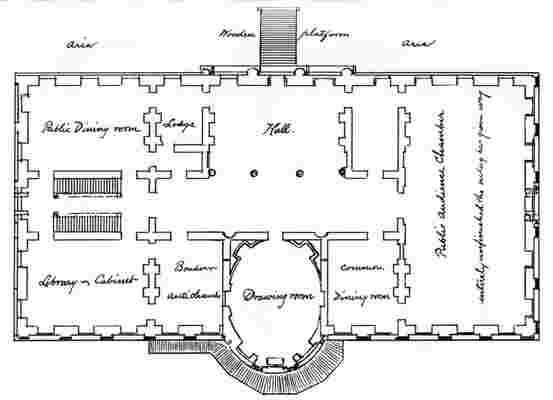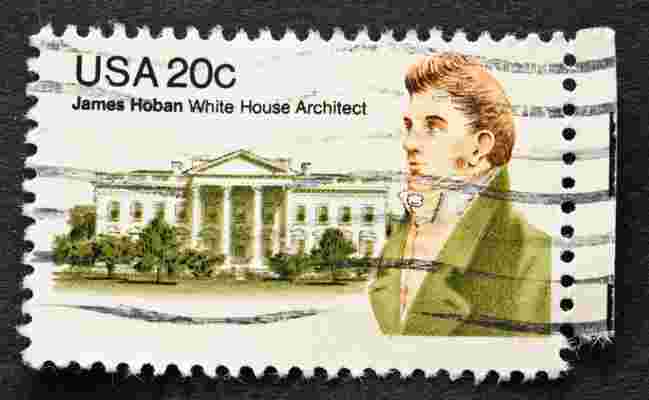December 01,2022
Meet the Man Who Designed and Built the White House
by David Stewart
Thomas Jefferson designed Monticello. Frank Lloyd Wright created Falling Water. Paul Revere Williams designed the Beverly Hills Hotel. While many architects of iconic landmark buildings remain renowned, the man behind the White House is elusive and unknown.
Until now. On St. Patrick’s Day, the Irish architect of the White House is revealed with an anthology of scholarly essays, as well as historic photographs, sketches, maps, newspaper clippings, and drawings. James Hoban: Designer and Builder of the White House ($49.95), published by the nonprofit White House Historical Association, studies the man and his craft by spotlighting his largest feat, the White House.

James Hoban's drawing of the White House in 1793.
“James Hoban’s story marks the beginning of the story of the White House itself,” says White House Historical Association president Stewart McLaurin, who edited the anthology. “I felt a comprehensive book on his life, influences, and accomplishments was long-overdue and decided to bring together a group of American, Irish, and British historians to share his story.”
The book addresses much of the mystery around the architect. McLaurin says that Hoban left little personal effects behind, and a fire in the 1880s destroyed Hoban’s papers. Only one wax portrait of him and several handwritten letters survive in the National Archives’ collection of Records of the Commissioners for the District of Columbia.
“It is curious, and atypical of architects of landmark buildings, that he is not more celebrated for his work on the White House like his contemporaries Benjamin Henry Latrobe or Charles Pierre L'Enfant are for their work in building the Federal City of Washington,” McLaurin says. The anthology hopes to change that. It includes detailed illustrations to accompany its prose, and draws interesting comparisons with the White House and contemporaneous Irish landmarks. Born in 1755, Hoban pulled inspiration for his designs from his youth in the Irish countryside. He was raised by rural tenant farmers on a country estate, called Desart Court, designed in the grand Palladian style. Neoclassicism, specifically neo-Palladianism, were the dominant architectural styles of Hoban’s time and can be seen in his sketches of the White House.

A drawing should Hoban’s original plans for the White House.
“It was Hoban who convinced George Washington, a man with a passion for the countryside, of the attractiveness of the grand Irish country house as a model for the United States,” the anthology reads.
Hoban was also inspired by his time studying at the Dublin Society School of Architectural Drawing in the 1770s. The anthology highlights three different buildings in Dublin that are reflected in the design of the White House. “The similarities in both the floor plan and the exterior façades between Leinster House, which now houses the Irish Oireachtas, and the White House are striking,” McLaurin says. The Royal Exchange and Newcomen Bank also influenced Hoban’s designs for the home of American presidents.
It wasn’t until Hoban left Ireland and emigrated to America that he had a chance meeting with President George Washington in Charleston in 1791. The meeting led the American president to hire Hoban as the designer of the White House.

A stamp honoring architect James Hoban was issued in 1981.
The anthology also addresses head-on the fact that Hoban was a slave owner. While Hoban is credited with the project, enslaved people played a role in the construction of the iconic structure, with all carpentry, stonemasonry, and brickwork under Hoban’s supervision.
“This book explores Hoban’s life and work through many lenses, and his status as a slave owner is another way through which we can learn about him,” says McLaurin. “Unfortunately, he was not unique in his slaveholder status in Washington during this early period of our country’s history. Ultimately, Hoban’s legacy as the architect of the White House is secure, but it took many hands—free and enslaved, skilled and unskilled—to bring his vision to life.”
With the publication of the anthology, the White House Historical Association celebrates its 60th anniversary. All proceeds from the sale of the association’s books are used to fund artwork and furnishings for the permanent White House collection, preservation efforts, and further the association’s educational mission.






